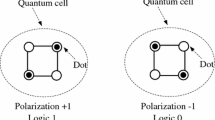Abstract
Quantum Cellular automata (QCA) is one of the promising next-generation technology which enables high performance and low energy Nano-electronic circuits. QCA presents a new dimension of ideas of designing the fundamental gates in digital electronics with minimum hardware. Here the logic level switching depends on the change in the polarization between the cells neglecting the current transfer which marks this viable technology as a promising candidate for upcoming generations. Moreover, the processing and transfer of information make use of quantum mechanics and cellular automata to deal with the disputes of CMOS transistor technology. In this manuscript, we have proposed the design of multi-logic gates using QCA architecture. The design layout has been simulated using QCA designer 2.0 and is in accordance with the desired logic. The results are compared with the existing design and found with less number of cells and less area.
Access this chapter
Tax calculation will be finalised at checkout
Purchases are for personal use only
Similar content being viewed by others
References
Aoun B, Tarifi M Quantum cellular automata, quant-ph/0401123
Porod W, Lent CS, Bernstein GH Quantum cellular automata. In: Annual report for the period 1 July 1993–30 June 1994, Department of Electrical Engineering University of Notre Dame
Bilal B, Ahmed S, Kakkar V (2018) An insight into beyond CMOS next generation computing using quantum-dot cellular automata nanotechnology. Int J Eng Manuf (IJEM) 8(1):25–37. https://doi.org/10.5815/ijem.2018.01.03
Michael Thaddeus Niemier BS (2004) Designing digital systems in quantum cellular automata. In: A thesis submitted to the Graduate School of the University of Notre Dame
Laajimi R (2018) Nanoarchitecture of quantum-dot cellular automata (QCA) using small area for digital circuits, intechopen
Lee Ai Lim A., Ghazali SC, Yan T, Fat CC (2012) Sequential circuit design using quantum-dot cellular automata (QCA). In 2012 IEEE international conference on circuits and systems (ICCAS), Kuala Lumpur, pp 162–167
Raj M, Gopalakrishnan L (2019) High speed memory cell with data integrity in QCA. In: 2019 3rd international conference on electronics, communication and aerospace technology (ICECA), Coimbatore, India, pp 926–929
Walus K, Schulhof G, Jullien GA (2004) High level exploration of quantum-dot cellular automata (QCA). In: Conference record of the thirty-eighth Asilomar conference on signals, systems and computers, Pacific Grove, CA, 2004, vol 1, pp 30–33
Anumula SK, Xiong X (2019) Design and simulation of 4-bit QCA BCD full-adder. In: 2019 IEEE long island systems, applications and technology conference (LISAT), pp 1–6. Farmingdale, NY
Dhare V, Mehta U (2019) A simple synthesis process for combinational QCA circuits: QSynthesizer. In: 2019 32nd international conference on VLSI design and 2019 18th international conference on embedded systems (VLSID), pp 498–499. Delhi, NCR
Blair E (2019) Electric-field inputs for molecular quantum-dot cellular automata circuits. IEEE Trans Nanotechnol 18:453–460
Isaksen B, Lent CS (2003) Molecular quantum-dot cellular automata. In: 2003 third IEEE conference on nanotechnology, 2003. IEEE-NANO 2003, vol 2, pp 5–8. San Francisco, CA
Chattopadhyay T, Sarkar T (2013) Design of AND-OR gate using quantum cellular automata and its cell-cell response using computer simulation. In: 2013 proceedings of 3rd national conference on electronics, communication and signal processing—NCECS
Author information
Authors and Affiliations
Corresponding author
Editor information
Editors and Affiliations
Rights and permissions
Copyright information
© 2020 Springer Nature Singapore Pte Ltd.
About this paper
Cite this paper
Avinashkumar, Borkute, A., Goel, N. (2020). An Efficient Design of Multi-logic Gates Using Quantum Cellular Automata Architecture. In: Goel, N., Hasan, S., Kalaichelvi, V. (eds) Modelling, Simulation and Intelligent Computing. MoSICom 2020. Lecture Notes in Electrical Engineering, vol 659. Springer, Singapore. https://doi.org/10.1007/978-981-15-4775-1_67
Download citation
DOI: https://doi.org/10.1007/978-981-15-4775-1_67
Published:
Publisher Name: Springer, Singapore
Print ISBN: 978-981-15-4774-4
Online ISBN: 978-981-15-4775-1
eBook Packages: Computer ScienceComputer Science (R0)




